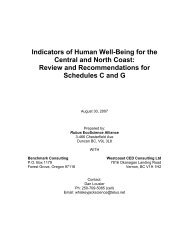West Babine Sustainable Resource Management Plan
West Babine Sustainable Resource Management Plan
West Babine Sustainable Resource Management Plan
You also want an ePaper? Increase the reach of your titles
YUMPU automatically turns print PDFs into web optimized ePapers that Google loves.
3.1.1.1 Biodiversity Elements<br />
a. Seral stage distribution and old growth retention<br />
Targets for early, mature plus old and old seral stages are based on an updated interpretation<br />
of the average fire return intervals for the Sub-Boreal Spruce (SBS) zone and the Englemann<br />
Spruce, Subalpine Fir (ESSF) zone (Steventon, 2002). The Interior Cedar-Hemlock (ICH)<br />
zone was not examined in that report and is therefore, based on the Biodiversity Guidebook<br />
(MoF 1996a). Furthermore, the Kispiox LRMP directs 12 per cent retention of old growth<br />
forest within each mid-sized watershed in the plan area. 9 This percentage has been met by<br />
mapping Core Ecosystems (see Map 6, page 71). Treatment Units identified by the <strong>Babine</strong><br />
LRUP (TU2, forest ecosystem networks) have been incorporated into these Core<br />
Ecosystems. 10<br />
b. Landscape connectivity<br />
Landscape Riparian Corridors have been mapped to provide connectivity of mature and old<br />
forest cover along valley bottom riparian areas and linking lowland to upland areas (see<br />
Map 6, page 71). Corridors are concentrated around major tributaries to the <strong>Babine</strong> River,<br />
and connections between high value wildlife habitat.<br />
c. Spatial distribution of cutblocks<br />
Targets for spatial distribution of cutblocks, also called “patch size distribution,” are based<br />
on the pattern that would be expected due to natural disturbances such as fire and windthrow.<br />
The distribution of patch sizes varies depending on the ecosystem. The assumption is that the<br />
wildlife and flora within these ecosystems will be adapted to the landscape pattern and will<br />
fare better if these patterns are emulated.<br />
d. Wildlife tree retention<br />
Targets have been identified to maintain structural features of old forests within harvested<br />
areas.<br />
Requirements for wildlife tree retention are greater when patches exceed 80 hectares<br />
(BCMoF, 1996a). This increase is to ensure that larger openings maintain the structural and<br />
functional features required by species, including connectivity and habitat structure for small<br />
animals such as furbearers. Maintaining habitat within cutblocks also supports First Nations<br />
interests in wildlife and trapping.<br />
e. Stand structure<br />
In addition to wildlife tree patches, additional consideration is required to maintain stand<br />
complexity, particularly in the ICH and the ESSF. Given the variable nature of this attribute,<br />
no objectives are provided. However, operational foresters should consider retaining advance<br />
9 This LRMP objective differs slightly from the targets outlined in the Landscape Unit <strong>Plan</strong>ning Guide. Because the LRMP<br />
objective is a higher level plan, it takes precedence over the Landscape Unit <strong>Plan</strong>ning Guide targets.<br />
10 Note: Zoning for Core Ecosystems does not impede the right of First Nations to exercise their traditional activities.<br />
March 2004 Page 13

















